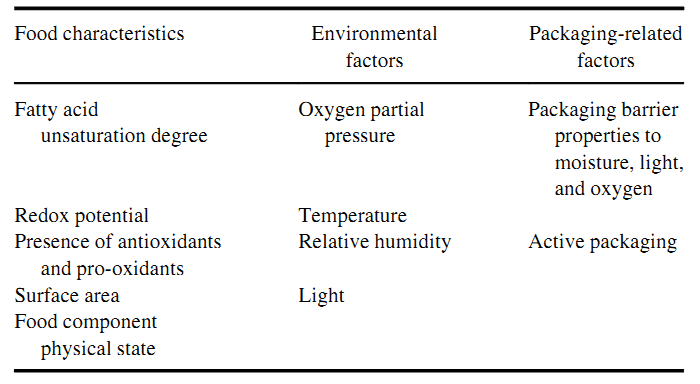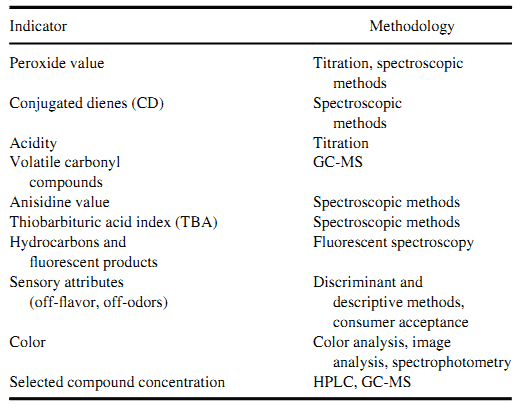Introduction
The time period for storing different types of food directly depends on the amount of lipids in each product and their susceptibility to oxidative rancidity. As a result of oxidising lipids with polyunsaturated fatty acids during the storage period, the quality of food deteriorates and changes in flavour and colour. Therefore, researchers and experts in food quality are interested in determining suitable approaches to storing products that directly address oxidation in foods containing different types of lipids (Matumoto-Pintro et al. 2017). The purpose of this paper is to discuss the factors influencing oxidative rancidity in relation to food with lipids and to analyse techniques applied to storing such foods.
Factors Affecting Oxidative Rancidity
Oxidation is a process in which molecules from the lipid family change as a result of oxygen. This process usually leads to a decrease in the biological activity of triglycerides, phospholipids, polyunsaturated fatty acids, carotenoids and phytosterols, and the development of unpleasant flavours and discolouring of foods (Ahmed et al. 2016; Matumoto-Pintro et al. 2017). Additionally, oxidative reactions in lipids lead to the formation of harmful toxic compounds affecting overall food quality (Calligaris et al. 2016). From this perspective, the progress of oxidative rancidity in foods with a high percentage of lipids depends on environmental aspects and packaging issues. According to Calligaris et al. (2016), food characteristics and qualities of lipids easily change due to factors such as oxygen, temperature, humidity, and specifics of packaging products (see Table 1). Due to lipid oxidation, the shelf life of various types of foods is reduced due to the effect of the quality of polyunsaturated fatty acids.

Approaches to Storing Food
Certain techniques used for storing food with a high percentage of lipids to prolong the shelf life include guaranteeing the quality of packaging and focusing on an appropriate temperature and humidity regimen. Certain types of products are expected to be stored only in refrigerators to avoid oxidation and prolong storage periods (Ahmed et al. 2016). It is important to ensure that products with polyunsaturated fatty acids, including fish and other sea products, are not exposed to air during storage (Ahmed et al. 2016; Calligaris et al. 2016). To monitor oxidative rancidity, experts examine such indicators as the peroxide value, acidity, anisidine value and others with the help of certain methods, for example, spectroscopic testing (Calligaris et al. 2016; Table 2). This approach tests the impact of certain conditions on oxidation in lipids depending on changes in storing foods (see Table 2).

Conclusion
Many products are at risk of seeing a reduction in quality within a short period of time because of observed oxidative reactions in lipids, particularly with regard to polyunsaturated fatty acids. As a result, the quality and features of foods change in association with oxidative rancidity. In order to address these processes during the shelf life of foods and their storage, it is necessary to follow certain rules on how to pack products and what environmental conditions to guarantee. Moreover, it is also important to regularly conduct quality tests to monitor changes in the various indicators that determine oxidative reactions in lipids in foods.
Reference List
Ahmed, M, Pickova, J, Ahmad, T, Liaquat, M, Farid, A & Jahangir, M 2016, ‘Oxidation of lipids in foods’, Sarhad Journal of Agriculture, vol. 32, no. 3, pp. 230-238.
Calligaris, S, Manzocco, L, Anese, M & Nicoli, MC 2016, ‘Shelf-life assessment of food undergoing oxidation–a review’, Critical Reviews in Food Science and Nutrition, vol. 56, no. 11, pp. 1903-1912.
Matumoto-Pintro, PT, Murakami, AE, Vital, ACP, Croge, C, Da Silva, DF, Ospina-Roja, IC & Guerra, AF 2017, ‘Effects of storage time and temperature on lipid oxidation of egg powders enriched with natural antioxidants’, Food Chemistry, no. 228, pp. 463-468.